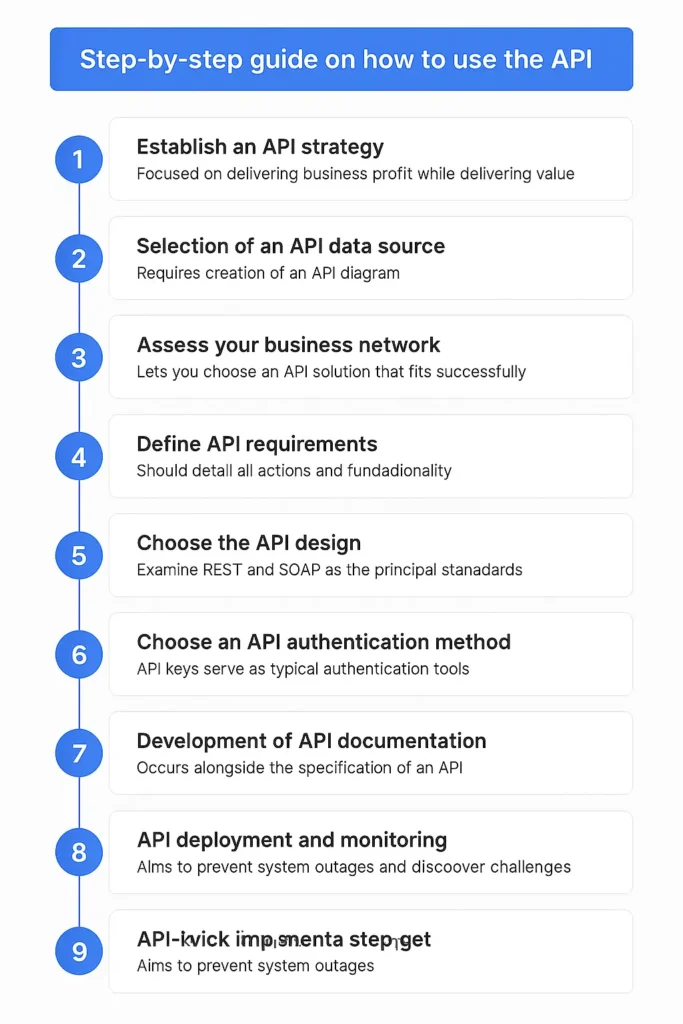Regular access to Application Programming Interfaces (APIs) occurs daily in numerous scenarios. The application programming interfaces, together with their associated advantages, enhance our daily experience through business operations and late evening DoorDash deliveries.
- What are the web APIs, and how do they matter?
- What does an API do?
-
Step-by-step guide on how to use the API
- 1. Establish an API strategy focused on delivering business profit while delivering value
- 2. Selection of an API data source requires creation of an API diagram
- 3. Assess your business network
- 4. Define API requirements
- 5. You must choose which architectural design the API data exchange system will use
- 6. Choose an API authentication method
- 7. The development of API documentation occurs alongside the specification of an API
- 8. API versioning enables proper maintenance of your latest API version
- 9. API deployment and development
- API Management and Monitoring
- Conclusion
Greater familiarity with APIs combined with improved knowledge of their functions will enable you to create organizational value through performance improvement of deficient areas and process optimization. This article presents a discussion about API implementation methodology while providing instructions for API usage and describing API fundamental elements alongside detailing REST and SOAP API patterns. Let’s discuss how to use the web APIs:
What are the web APIs, and how do they matter?
An API functions as a connecting tool between applications while maintaining its importance.
- APIs serve as connection points between applications, which facilitate their communication. APIs provide businesses with advantages when exchanging data with external entities and third-party software, which includes multiple business intelligence tools. APIs hold value beyond basic interpretation functions.
- According to API standards, software applications can exchange data using established communication rules. An API operates as a communication channel that enables application data transfers while providing access to other program functionalities or generating fresh application solutions.
- Software developers can utilize APIs to integrate any existing service or feature from external applications without creating their versions of the services. Development speed accelerates because developers do not need to produce original code through APIs. These systems can be reused for standard procedures, but their functionality is limited to approved users.
- A complete tutorial demonstrating how to work with API systems
- Both applications need to follow the established rules and protocols to perform effective communication. The parties in client-server relations need to meet their defined responsibilities. The API developed by companies needs to understand its function, along with the request procedure for customers to obtain responses from the client.
- The documentation should provide complete instructions about endpoints while specifying requested headers together with data specifications and required parameter values. The server-side application requires the right combination of predefined parameters and headers as part of valid API requests made through HTTP methods so that it can generate appropriate responses to clients. The API development process starts with API documentation, which leads to testing of the developed API before its movement into production.

What does an API do?
APIs have distinct operations based on how they will be employed.
- An API functions as a platform that enables one application to access the services operated by another application without needing programming code. The user must read the API documentation to understand what the API can perform because this documentation presents available API requests with examples.
- APIs simplify backend programming requirements for the requesting applications, allowing businesses to enhance operational efficiency and productivity. The API provides everyday users with rapid capabilities to process mobile payments and helps them schedule flights and access rideshare applications, and access current weather data.
- Business operations, together with daily personal activities, achieve better productivity through the application of APIs.
Step-by-step guide on how to use the API
Successful implementation of API applications requires four successive steps that follow this pattern.

1. Establish an API strategy focused on delivering business profit while delivering value
A business should start by clarifying its main goal when developing an API application. The API aims to either boost revenue levels or improve operations, or convert existing technology or data collections into new revenue streams.
2. Selection of an API data source requires creation of an API diagram
A developer should first understand API requirements, which include endpoint parameters, HTTP methods, in addition to the database data that the API needs to retrieve its results. All discussions regarding error handling need to occur before establishing both data models and the activities involved in accessing data sources.
3. Assess your business network
An assessment of your current business network will let you choose an API solution that fits successfully into your existing setup. For proper implementation of your API solution, you should hire an integration specialist to assess its compatibility with your current hardware and software.
4. Define API requirements
Predefined specifications should detail all actions and functionality that the API will deliver. Assess how well the API will execute its functions to improve business operations and enhance customer experiences, as well as satisfy customers and generate revenue increases. You should establish API requirements as you move forward with the original API strategy.
5. You must choose which architectural design the API data exchange system will use
Among different types of APIs, the article examines REST and SOAP as the principal standards. The article explores the REST API as its main subject. The REST API serves average business requirements since developers need minimal coding to finish assignments, while its structure provides greater flexibility compared to the SOAP API.
6. Choose an API authentication method
API keys serve as typical authentication tools for REST APIs because developers can embed them in query strings or request headers. The OAuth 2.0 protocol serves best when you need to access user data through applications, including Facebook and Google. Username and password authentication stand as one of the least secure authentication methods.
7. The development of API documentation occurs alongside the specification of an API
Many tools exist for API applications that assist developers in maintaining API software while automating documentation generation. An API documentation tool performs automatic updates of the documentation whenever the specification requirements change to match the requirements. The tools enable rapid developer onboarding of your API through documentation creation that delivers user-friendly insights to developers without requiring help from your team.
8. API versioning enables proper maintenance of your latest API version
Your users and developers need to understand which APIs already exist during each release. A simple solution to perform version control includes using ver1 or ver2 appended to your URL path at the endpoint. The title of your API documentation must receive updates when your technology receives new versions by adding simple numerals like v2 or v3 at its end.
9. API deployment and development
API development tools help developers tackle application development difficulties through efficient time usage and cost reduction, and quick error detection, as well as third-party integration and system consolidation features. A Continuous Integration/Continuous Delivery system enables automated application deployment that allows seamless, fast deployment of API applications without requiring human participation.
10. Monitoring an API app
The API has achieved its initial objective in the API strategy when it runs effectively while matching all pre-defined performance metrics. API monitoring software functions to ensure API application success by detecting power or network outages and measuring API availability as well as tracking error rates and monitoring latency, and observing traffic spikes.
API Management and Monitoring
- API monitoring must aim to prevent system outages by handling problems early and discovering operational challenges that affect performance, as well as resolving issues that would compromise customer satisfaction or lead to lost income.
- The successful implementation of a successful API follows sequential steps that establish the base for your API application. API performance optimization needs to remain flawless throughout the online period since development and deployment form the essential core for building and operating an API.
- The implementation of an API requires active monitoring alongside practical update execution when business processes change during operation. The API strategy requires automated tools for API development and monitoring, which ensure that the implemented API meets its intended objectives.
Conclusion
The tutorial taught users to connect with web APIs that operate through varied styles of service implementation. The value of adding error-handling functions became clear to you as this made both debugging processes more efficient and scripts more reliable. Your main objective was to combine the requests and JSON modules for protection from technical implementation details while conducting your work, and you further organized request-response tasks into reusable functions to improve script modularity.
You possess a standardized method to study any new web API after completing this procedure.
- Review the introductory part of the available documentation to learn basic API interaction methods.
- The script must include basic error handling together with authentication token acquisition, then you can add modules to send basic requests while handling responses and errors.
Develop specific requests that extract the necessary service information.
You need to apply this learned information by exploring another API service or additional features within one of the APIs you have already utilized. Your project will activate the knowledge acquired in this lesson.





